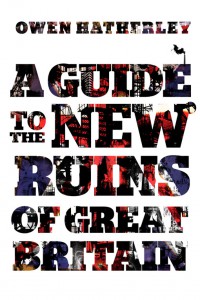Featured interview: MULE speaks to Owen Hatherley (part 2)
Article published: Wednesday, March 9th 2011
In the second part of Andy Lockhart’s interview with Owen Hatherley, the author talks about the importance of Manchester’s radical culture scene in the city’s marketing strategy, what he likes about the Yellow Bricks in Hulme, and the future of regeneration under the coalition government.
 Andy Lockhart: In the book you make an interesting connection between Manchester’s famous music scene and today’s property developers. Could you tell us what this is all about?
Andy Lockhart: In the book you make an interesting connection between Manchester’s famous music scene and today’s property developers. Could you tell us what this is all about?
Owen Hatherley: I think it’s partly the self-presentation of them – like Nick Johnson’s talk where he basically says the foundation of Urban Splash is the Sex Pistols playing at the Free Trade Hall. They actually say this. In terms of people who are actually involved it’s far trickier. Certain people were involved directly. Alan McGee got into property development, Mick Hucknall’s in property development, though I think it’s quite rare to find people who were involved in both. People who are involved in property – I imagine in many cases they were on the fringes of that stuff, Bloxham was certainly involved in the music scene and in the Labour Party left as well – consciously say, “We are in this tradition.” And towards the end Tony Wilson was saying it too: “You are the inheritors of Factory Records.”
There’s a documentary called ‘New Order Play at Home’ for Granada TV in about 1984. There’s Tony Wilson who’s in the bath interviewed by Gillian from New Order who’s wearing a wedding dress in the bath as well. So she’s at one end and Wilson’s at the other. It’s a fantastic documentary. But there’s a bit where Gillian asks Wilson something like, “what are your ambitions” and Wilson says, “I’d like to see the revolution in my lifetime’, and later says; ‘I’d like to open a New York office, and I would like to build lofts in Manchester.” This is 1984 – 12 years before it actually happens in Manchester. The reason was because they’d just been to New York. It was a time when the radical arts scene, punk and post-punk in New York were very much providing the foundations for gentrification there. People involved with that scene were then involved in the loft apartments scene.
In a way it’s hard to resent them and again this is the major flaw in my stuff about Manchester. The thing is I don’t remember it when it was fucked. Of course outside the ring road it’s still fucked, but the centre isn’t. I think that if you were walking around Whitworth Street when all that area was derelict with that level of grandeur going to waste, then you went somewhere where very similar buildings were actually inhabited and used, and there was street life – of course you’d want that. The problem with it is that the critical faculties just seemed to disappear around the same time. But I understand the rationale. My main source for a lot of this was Justin O’Connor who was involved in the study of – I hate the phrase – ‘creative industries’ in Manchester. He was one of those involved in founding Urbis. He was involved early on and then thought, “Hang on.” Not enough people did that in my opinion. The sad thing about all this is that Richard Leese recently described himself in an interview as a socialist. I’m sure Bloxham would too. I’m sure Wilson thought he was a Situationist until the end. They still think they’re radicals when they’re serving land and property.
AL: There’s a point where you call Homes for Change – the Yellow Bricks – in Hulme “the most interesting housing scheme in contemporary Manchester.” Why do you think this?
OH: I got a bollocking for this recently because I was giving a talk to University College London which is very much the heart of this – the urban renaissance is UCL’s fault in lots of ways. I was getting to the end and was trying to point to something where I could say, “This is how things could possibly be.” Otherwise it’s just relentless misery. And the two examples I’d use for that are always in Manchester. And they are Islington Square and Homes for Change. I was talking about Homes for Change and the things I liked about it – the fact that it’s run as a cooperative and that it reuses a lot of the better ideas of the sixties: the walkways and the large public space in the middle for instance. They insisted on all the things they’d been told couldn’t work. Whenever they redevelop an area like that it’s always, “Right, we’re now going to give you defensible space, lots of CCTV,” and so on. Instead they asked for something that was very similar in design to Hulme Crescents, except about one tenth of the size. I found this really interesting.
However, after the talk someone said to me: “Yes, but it is a gated community.” And it is, I can’t deny it. That public space in the middle is great, but when they close the gate… It feels quite public – I’ve walked in and out of it a few times. But I think it has many interesting aspects to it. If there were lots more cooperatively owned and run housing schemes with walkways I’d be very happy. Those kinds of ideas were attempted en masse at Hulme Crescents. The problem is that it’s an enclave, but this guy was arguing for gated communities. He was saying that the reason Homes for Change works is that it’s a gated community and because it’s localism in practice. Its residents are very conscious that it’s their thing. If it was done on a wider scale it would be fantastic. The question is whether it works because it’s a gated community – and I don’t think it’s true.
The main thing about Hulme Crescents was that they were astoundingly badly built; unlike Park Hill in Sheffield – the better built original version where they didn’t just slap it together with concrete panels and barely any insulation. There they did it properly. Even now when you’ve two thirds of it being taken over by Urban Splash, you walk around those walkways and they’re full of people sitting around and talking to each other. I thought that was quite encouraging and in Homes for Change I thought it showed that there is some life in that idea – in communal housing rather than obsessive privacy. It is still quite encouraging despite my reservations.
AL: Obviously the book is mainly about New Labour and what’s left behind. What do you expect to see in the future under this government in terms of urban development and in Manchester?
OH: The complete collapse of everything! I expect to see what’s happening in Ancoats everywhere. They laid the foundation for that. I don’t think Alistair Darling’s version of cutting the deficit would have been by any means immeasurably better. In many cases though they’re cutting off things that are actually quite dodgy, but they’re not replacing them with anything. They’re getting rid of Pathfinder. Great, but it actually means all the places that are derelict are going to stay derelict. They get rid of regional development agencies. Great, we’ve no longer got completely unaccountable quangos administering these huge areas, but no one else is going to. If Pathfinder was replaced by a council housing scheme and the RDAs were replaced with democratically elected metropolitan councils then fine, but they’re not.
AL: What about the Local Enterprise Partnerships?
OH: I imagine the LEPs are going to be very similar to those things in the eighties in places like Middlesbrough. You’d have a load of chippy businessmen getting together and they’d build themselves a business park or something. I think it’s a recipe for sort of eighties’ urbanism – or disurbanism – all over again. In London I think they’re trying to keep the city centre apartments thing going. The capping of housing benefit and getting rid of life-long tenure is all designed to keep the property boom going in the capital going – by freeing up council housing.
Since within the ring-road of Manchester you don’t have any council housing that’s not going to have quite the same effect here. But then the Tories know that no one in east London, Manchester, Liverpool, west Yorkshire, Scotland or Wales votes for them. They’ve got a pitiful mandate and they seem quite content to let the cities rot – hoping for another eighties-style boom on the edges of the M25. I think they’re staking a lot on that. Lots of the companies which have been induced to come to the centre of Manchester – the Bank of America, RBS – they’re still being given huge dispensation from the state and they’ll still be anchored here. The rug isn’t going to be pulled from under that.
What you’ll see I think is the natural conclusion of New Labour in a lot of ways, an exacerbation of the kind of Parisian urbanism that Manchester has, where have a central part where people are very very rich and an outer bit where people are very very poor. And you’ll get riots, and I think we’ll see lots of them if they serve their full term. And I’d like to see when that explosion happens that we don’t end up back in the arms of Sir Richard Leese and Hazel Blears. Whether it’s through some alternative to the Labour Party or a retaken Labour Party I don’t really care. As long as it doesn’t end up with a slightly reformed New Labour coming back leaving in all the reforms the Tories have made, but I think that’s a real possibility. It’s going to be bleak, very bleak indeed.
Owen Hatherley blogs at nastybrutalistandshort. His first book, Militant Modernism, was published by Zero Books in 2009. A Guide to the New Ruins of Great Britain was published in 2010 by Verso. Part 1 of the interview can be found here.
More: Features, Interviews
Comments
-
[…] – from MULE speaks to Owen Hatherley, part 2 […]
Pingback by “I’m sure Wilson thought he was a Situationist until the end” « Flat 7 on March 11, 2011 at 2:17 am -
[…] […]
Pingback by After the Riots: what is the ‘real Manchester’? | Red Pepper blog | Red Pepper on August 12, 2011 at 1:50 pm -
[…] click on LINK to read full […]
Pingback by Featured interview: MULE speaks to Owen Hatherley (part 2) « on August 21, 2012 at 12:21 am
The comments are closed.





